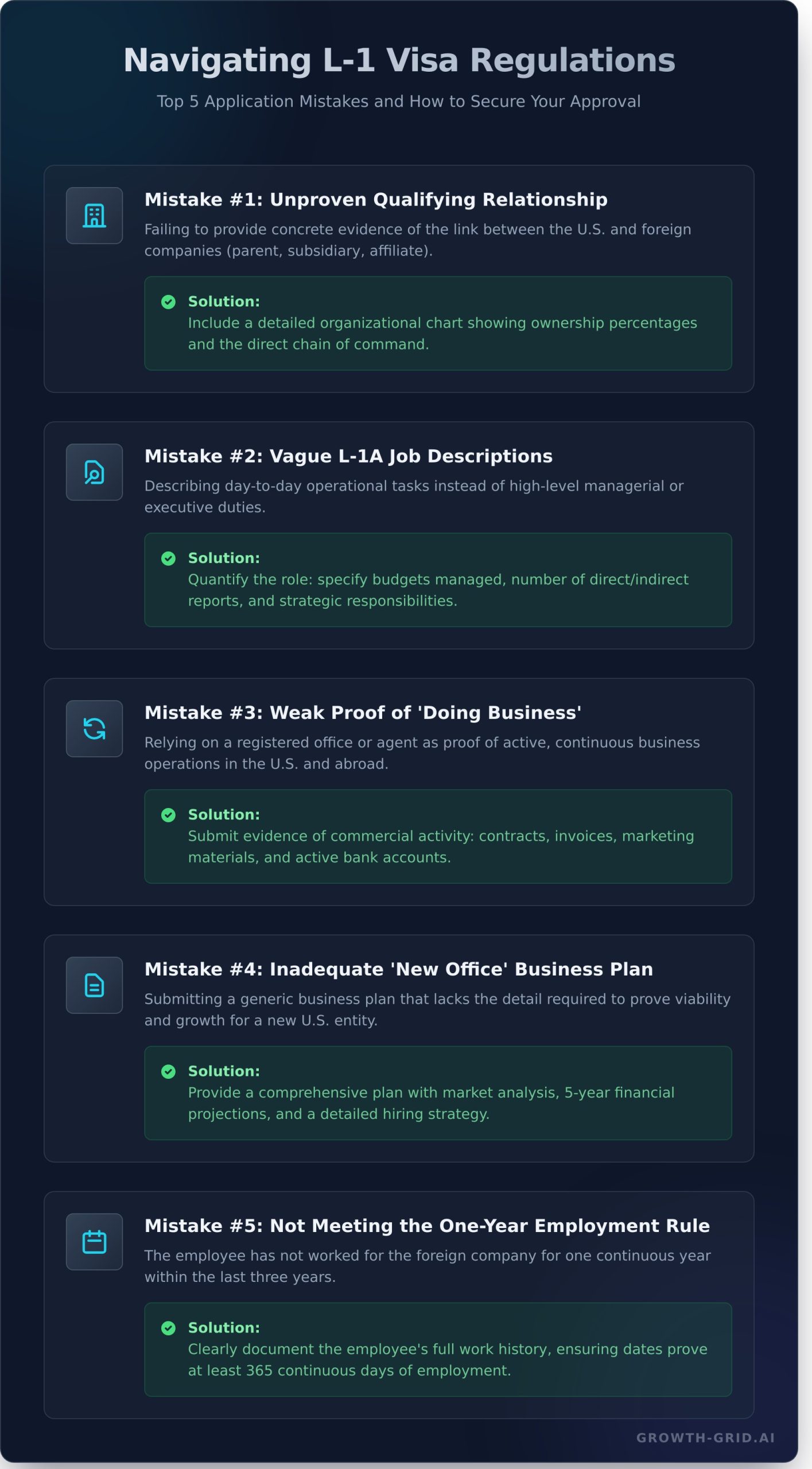Navigating the world of U.S. immigration can feel overwhelming, especially when your company’s expansion depends on it. The L-1 visa is a powerful tool for transferring key employees, but its regulations are strict and complex. A single mistake on your application can lead to costly delays or even outright rejection. This guide will help you understand the key L-1 visa rules and avoid the common application pitfalls that stop businesses in their tracks.
What are the L-1 Visa Regulations? A Simple Breakdown
At its core, the L-1 visa is designed for intracompany transferees. It allows a U.S. employer to transfer an executive, manager, or employee with specialized knowledge from an affiliated foreign office to one of its offices in the United States. It’s the perfect solution for leveraging existing talent to grow your U.S. presence. To choose the right path, you must first understand the two main categories of the L-1 visa.
L-1A Visa for Executives and Managers
The L-1A visa is specifically for employees who will work in a managerial or executive capacity. This doesn’t just mean having a title; it requires proving that the employee will primarily oversee departments, manage other professionals, or direct key functions of the business. An approved L-1A visa typically grants an initial stay of up to three years, providing a solid foundation for your U.S. leadership team.
L-1B Visa for Specialized Knowledge Workers
The L-1B visa is for employees who possess “specialized knowledge.” This refers to an advanced level of understanding of the company’s unique products, services, research, systems, or management techniques. The key is that this knowledge is not common in the industry and cannot be easily transferred to another person. Like the L-1A, the initial period of stay granted is typically up to three years.

5 Common Mistakes That Violate L-1 Regulations (and How to Avoid Them)
United States Citizenship and Immigration Services (USCIS) scrutinizes every L-1 petition against a strict set of criteria. Small errors or omissions can quickly lead to a denial, wasting months of time and significant financial resources. Your business plan is the most critical piece of evidence you can provide to proactively address these requirements and prevent common mistakes.
Mistake #1: Failing to Prove a ‘Qualifying Relationship’
A core regulation of the L-1 visa is that the U.S. and foreign companies must be properly linked as a parent, subsidiary, branch, or affiliate. Simply stating this relationship exists is not enough. How to avoid it: Your business plan must include a detailed organizational chart that visually and explicitly shows the ownership structure. Clearly state the ownership percentages and the direct chain of command between the two entities to leave no room for ambiguity.
Mistake #2: Vague Job Descriptions for Managers or Executives
The regulation for L-1A applicants requires that they perform high-level duties, not just the day-to-day operational tasks of the business. An executive doesn’t just manage a project; they direct a major function of the company. A manager doesn’t just do the work; they manage other professional employees. How to avoid it: The personnel section of your business plan must detail the applicant’s specific managerial duties. Quantify their role by including the budgets they will manage, the number of direct and indirect reports they will have, and the strategic decisions they will be responsible for.
Mistake #3: Weak Proof of ‘Doing Business’ in the U.S. and Abroad
USCIS regulations require that both the U.S. and foreign entities be actively and continuously providing goods or services. The mere presence of an office or registered agent is not sufficient. How to avoid it: Your business plan must serve as concrete evidence of commercial activity. Include details about existing contracts, client invoices, marketing materials, and active business bank accounts. Furthermore, your financial projections should clearly demonstrate the viability and ongoing operations of both the foreign and U.S. entities.
Mistake #4: An Incomplete Business Plan for a ‘New Office’
If you are using the L-1 visa to send an employee to establish a new office in the U.S., the regulations demand an exceptionally detailed business plan. This is one of the most common points of failure for new applicants. How to avoid it: Your plan must go beyond basics. It needs to include a thorough market analysis, comprehensive 5-year financial projections (personnel, operating costs, revenue), and a detailed hiring plan. Crucially, it must prove that the new U.S. entity will be large enough to support a manager or executive within one year of its establishment. Don’t risk it with a generic template. Generate a USCIS-ready business plan in minutes. ✨
Mistake #5: Not Meeting the One-Year Employment Requirement
This is a straightforward but non-negotiable regulation. The employee being transferred must have worked for the qualifying foreign company for one continuous year within the three years immediately preceding the application. There is no flexibility on this point. How to avoid it: Clearly state the employee’s full employment history in the application documents and reference it in the personnel section of the business plan. Ensure the dates are accurate and demonstrate at least 365 days of continuous employment with the foreign entity.
Frequently Asked Questions (FAQs)
What are the main L-1 visa requirements for the employer?
The employer must have a qualifying relationship with a foreign company (parent, subsidiary, affiliate) and must be actively doing business in both the U.S. and at least one other country.
What are the L-1 visa eligibility criteria for the employee?
The employee must have worked for the foreign company for one continuous year out of the last three years and must be coming to the U.S. to serve in either an executive/managerial capacity (L-1A) or as a specialized knowledge worker (L-1B).
How long can you stay in the U.S. on an L-1 visa?
The initial stay is typically up to three years (or one year for a new office). Extensions are possible, with a maximum total stay of seven years for L-1A visa holders and five years for L-1B visa holders.
Can my family come with me on an L-1 visa?
Yes, your spouse and unmarried children under 21 can apply for L-2 visas to accompany you. Spouses on an L-2 visa are typically eligible to apply for work authorization in the U.S.
Is it possible to extend an L-1 visa?
Yes, L-1 visas can be extended in two-year increments until you reach the maximum limit (seven years for L-1A, five years for L-1B).
What is the difference between an L-1A and an L-1B visa?
L-1A is for executives and managers who direct the organization or a major part of it. L-1B is for employees with specialized, proprietary knowledge of the company’s products, services, or procedures.
A successful L-1 visa petition hinges on providing clear, overwhelming evidence that you meet every single regulation. The most powerful tool at your disposal is a comprehensive, detailed, and professional business plan tailored specifically to USCIS requirements. By avoiding these common mistakes, you can significantly increase your chances of approval and get your key personnel on the ground in the U.S. faster. Stop worrying about compliance and start building your American presence. Create your L-1 visa business plan with AI now. ✨ You can generate a 72-section, USCIS-compliant business plan and save over 90% on traditional consultant fees, joining thousands of entrepreneurs who trust our platform.
